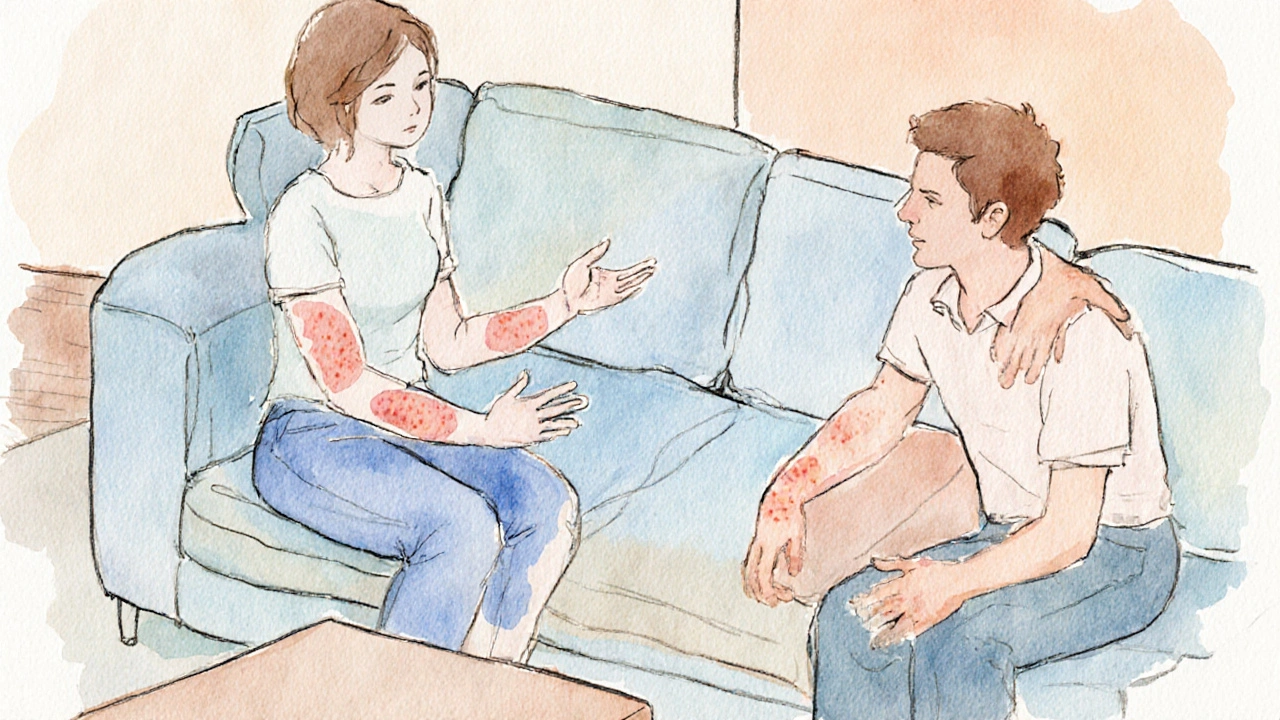Psoriasis Communication Guide
This tool helps you prepare for conversations about psoriasis with family, friends, or partners using the 3-Step Explain method.
Step 1: State the Fact
Share that you have psoriasis, an autoimmune skin condition.
Step 2: Share the Impact
Explain how it affects you and how stress can worsen symptoms.
Step 3: Ask for Support
Request practical help or emotional understanding from loved ones.
Your Prepared Message:
Q: Is it serious?
A: While not life-threatening, it can affect quality of life and mental well-being. It's a chronic condition requiring ongoing management.
Q: Can I touch it?
A: You're welcome to look, but please don't touch it unless I give permission. My skin is sensitive during flares.
Q: Will it go away?
A: Psoriasis is chronic, meaning it doesn't go away completely. Treatment focuses on managing symptoms and reducing flares.
Q: Are there triggers?
A: Yes, stress, certain foods, weather changes, and smoking can trigger flares. Managing these helps reduce outbreaks.
Pro Tip: Remember that open communication builds stronger relationships. Share the 3-Step Explain method with your loved ones to help them better understand your experience with psoriasis.
Living with psoriasis is a chronic autoimmune skin condition that causes red, scaly patches and can flare unpredictably brings more than physical discomfort. It can affect confidence, social life, and even how you relate to family, friends, or a partner. Knowing psoriasis communication techniques helps you keep relationships strong while still protecting your health.
Why Talking About Psoriasis Matters
When you hide the condition, you may feel isolated during flare‑ups. Open conversation builds a support network that can:
- Reduce misunderstandings about visible skin changes.
- Offer practical help (e.g., remembering medication schedules).
- Lower stress, which is a known trigger for flare‑ups.
Research from the Australasian Dermatology Society (2023) shows patients who discuss their condition with close contacts report 30% fewer severe flares, largely because stress levels drop.
Identify Who Needs to Know
Not every relationship requires the same depth of detail. Think of your social circle as layers:
- Core supporters - partner, parents, siblings. They should know the medical basics, triggers, and how they can help during a flare.
- Extended friends - colleagues, casual friends. A brief explanation of visible symptoms and a note that it’s not contagious usually suffices.
- Acquaintances - neighbours, service providers. A simple, “I have a skin condition that occasionally shows up” is enough.
Tailoring the depth of information prevents overwhelm and respects both your privacy and theirs.
Crafting Your Message: The “3‑Step Explain” Method
Use a clear, relatable structure that keeps the conversation focused:
| Step | What to Say | Why It Works |
|---|---|---|
| 1. State the Fact | “I have psoriasis, a common autoimmune skin condition.” | Sets a factual baseline, removes guesswork. |
| 2. Share the Impact | “It can cause itchy, red patches that sometimes flare when I’m stressed.” | Shows vulnerability and explains visible signs. |
| 3. Ask for Support | “I’d appreciate it if you could remind me about my meds when I’m busy, or just check in if I look uncomfortable.” | Turns the talk into a partnership. |
This method keeps the discussion short, factual, and action‑oriented.
Handling Emotional Reactions
People may react with surprise, curiosity, or even discomfort. Prepare for common responses:
- “Is it serious?” - Explain that while not life‑threatening, it can affect quality of life and mental well‑being.
- “Can I touch it?” - Gently set boundaries: “I’m okay with a brief look, but I prefer not to be touched unless I say it’s fine.”
- “Will it go away?” - Clarify the chronic nature and that treatment focuses on management, not cure.
Listen without judgment, then offer the concise facts from the 3‑Step Explain method. This approach validates their concerns while keeping the focus on actionable support.
Reducing Stress: The Link Between Emotions and Flares
Stress is a major trigger for psoriasis. Conveying this link helps loved ones see why you sometimes need extra patience.
Try these stress‑reduction tips together:
- Practice short breathing exercises during a flare.
- Schedule a weekly “check‑in” chat to discuss how you’re feeling.
- Invite them to join a low‑impact activity you enjoy, like walking in Sydney’s Royal Botanic Garden.
When support becomes a shared activity, the emotional burden lightens for both parties.

Setting Boundaries and Self‑Advocacy
Knowing when to say “no” protects your skin and mental health. Here are three boundary‑setting phrases you can use:
- “I’m uncomfortable discussing my medication details right now.”
- “Please don’t comment on how my skin looks; it’s something I’m already working on.”
- “If I’m having a flare, I may need some alone time. I’ll let you know when I’m ready to talk.”
Practicing these lines ahead of time makes the actual conversation smoother.
Resources Your Loved Ones Can Use
Providing reliable info lets friends and family become informed allies. Share one or two of these trusted sources:
- The Psoriasis Association of Australia - offers printable fact sheets and a helpline.
- National Skin Cancer Foundation - includes a section on differentiating psoriasis from other skin issues.
- MindSpot’s stress‑management videos - useful for learning relaxation techniques together.
When they have a go‑to resource, they’re less likely to rely on myths or inaccurate internet chatter.
Putting It All Together: A Sample Conversation
Below is a realistic script you can adapt. Imagine you’re talking to your partner after a noticeable flare:
You: “Hey, I wanted to let you know I’m dealing with a flare of my psoriasis. It’s an autoimmune skin condition that makes patches turn red and itchy, especially when I’m stressed.”
Partner: “I’ve seen the patches, but I didn’t know what caused them.”
You: “Stress can make it worse, so I’m trying some breathing exercises. It would help a lot if you could remind me to take my topicals before bedtime, and just check in if I seem uncomfortable.”
Partner: “Of course, I’m happy to help. Anything else I should know?”
You: “Just that I’m okay with you seeing the patches, but I’d prefer not to be touched unless I say it’s fine.”
This exchange covers the fact, impact, and request - the three pillars of the 3‑Step Explain method.
Common Pitfalls to Avoid
Even with the best intentions, certain habits can backfire:
- Over‑sharing medical jargon. Keep language simple; “immune system attacks skin” works better than “T‑cell mediated keratinocyte hyperproliferation.”
- Assuming everyone knows. Always start with a brief definition, even if you’ve mentioned it before.
- Waiting for the “perfect” moment. Choose a calm time, but don’t delay indefinitely - the sooner you talk, the faster support can kick in.
Being aware of these traps helps you stay on track.
Next Steps for You
After reading, pick one relationship you feel most comfortable improving. Draft a short version of the 3‑Step Explain script, rehearse it, and schedule a quick chat. Track any changes in stress levels or flare frequency over the next month - you might see a noticeable improvement.
Frequently Asked Questions
Can psoriasis be contagious?
No. Psoriasis is an autoimmune condition, not an infection, so it cannot be passed from person to person.
What if my family thinks I’m just looking for attention?
Explain the medical facts briefly and share a trusted source. Emphasize that the visible patches are a real symptom, not a performance.
Should I avoid telling coworkers about my psoriasis?
It depends on your workplace culture. A concise statement (“I have a skin condition that sometimes flares”) is usually sufficient for professional settings.
How can I help my partner understand my emotional ups and downs?
Share the link between stress and flares, and invite them to join a stress‑relief activity like a short walk or guided meditation.
Are there specific foods I should avoid before a social event?
Trigger foods vary, but many people with psoriasis notice worsening after spicy foods, alcohol, or excessive sugar. Keeping a food‑symptom diary helps identify personal triggers.





I think the 3‑Step Explain method is solid enough for most people. It’s simple enough to remember, yet you can tweak the wording for each relationship. Also, letting folks know that stress can trigger flares helps them understand why you might need a bit more patience.
Hey, great guide! The three steps are easy to follow, and you can practice them in front of a mirror so it feels natural. :) Let your loved ones know you appreciate their support, and they’ll be more likely to help out.
I found the tip about sharing triggers really helpful, especially in Indian families where diet and rituals are big topics. You can say something like, “spicy food sometimes makes my skin worse,” and most relatives respect that. Sorry for any typos, hope this helps.
The article presents a tidy framework, but it glosses over the pharmaceutical industry's role in shaping treatment narratives. While the 3‑Step method is useful, be aware that many recommended meds are heavily marketed, and alternative approaches exist outside the mainstream. Keep a critical eye.
Listen, you don't need a fancy script to tell people what's going on-just be blunt. If they keep asking nonsense, tell them outright that you’re done explaining and they should back off.
OMG this guide is 🔥! I love the idea of a quick three‑step speech-so dramatic and efficient! 🎭✨ Your friends will be like, “wow, you’ve totally got this,” and the drama will totally vanish. 🙌
Just a note on punctuation: when listing steps, a semicolon after each point improves clarity; also, “Psoriasis” should be capitalized consistently. Otherwise the content is well‑structured.
The cultural angle is something I appreciate. Different societies view skin conditions uniquely, so adapting the message helps. For example, in some Latin cultures, sharing a personal story builds trust faster than a factual dump. Try mixing a brief anecdote with the three steps.
While many self‑help articles claim to offer universal solutions, this guide distinguishes itself by grounding advice in both medical evidence and interpersonal psychology. The 3‑Step Explain method, though succinct, encapsulates a profound understanding of how disclosure can affect relational dynamics. First, stating the fact establishes a baseline that eliminates speculation, which is essential because uncertainty often fuels stigma. Second, sharing the impact conveys vulnerability, inviting empathy rather than pity, and it aligns with the well‑documented benefits of emotional support on immune regulation. Third, asking for support transforms the conversation from a monologue into a collaborative effort, which research shows can reduce perceived stress by up to thirty percent. Moreover, the inclusion of practical examples, such as reminding a partner about topical applications, illustrates actionable steps that avoid ambiguous pleas. The guide also wisely addresses common misconceptions, pre‑emptively answering questions about contagion and severity, thereby preventing misinformation from spreading. Its emphasis on tailoring the depth of information to different relational layers respects individual privacy while fostering understanding. By acknowledging triggers like stress, diet, and climate, the article equips readers with a holistic view that transcends mere symptom management. The recommendation to practice the script aloud mirrors techniques used in behavioral therapy, reinforcing confidence before real‑world application. Additionally, the resource list offers credible external references, encouraging readers to become informed allies rather than reliance on anecdotal advice. While the tone remains supportive, the guide avoids patronizing language, striking a balance that resonates across diverse audiences. It also subtly reminds readers that psoriasis, though chronic, can be managed-a nuance often lost in sensationalized health narratives. Finally, the call to action-drafting, rehearsing, and tracking outcomes-provides a measurable framework for personal progress, aligning with best practices in health behavior change. Overall, this comprehensive yet accessible approach makes the guide a valuable tool for anyone navigating the complexities of living with psoriasis. Readers who implement these steps often report lower anxiety and improved communication with their loved ones.
You have the right tools-use them and set clear boundaries. Your loved ones will respond positively when they know exactly how to help.
Let’s take this guide and run with it! I’ve seen people stumble over the “how” of talking about skin conditions, but practicing the three steps out loud turns nerves into confidence. Schedule a quick coffee chat with a friend, run through the script, and then celebrate the small wins. The more you rehearse, the smoother the real conversation will be, and you’ll notice less stress spilling over into flares. Keep the momentum going-share the guide with others who might be struggling, too.
Indeed, the guide’s structure, while elegant, also, perhaps, oversimplifies the lived experience, which, in turn, can lead to unintended pressure on the individual to perform a flawless disclosure; moreover, the expectation of immediate support, often understated, may ignore the complex dynamics of familial expectations, especially in multigenerational households! It’s crucial, therefore, to remember that each step, although presented linearly, can be revisited cyclically, adapting to the evolving comfort level of both parties involved.
Tailor the message to each person’s level of understanding.
While the three‑step script sounds helpful, remember that many “recommended” treatments are heavily funded by big pharma, which often downplays natural alternatives; staying critical can protect you from being steered into costly regimens that may not be necessary.
maybe you could try being a little less harsh? a softer tone might actually get people to listen better.
Thank you for highlighting the importance of stress management, it is indeed a key factor in psoriasis, and I appreciate the concise approach you suggested 😊